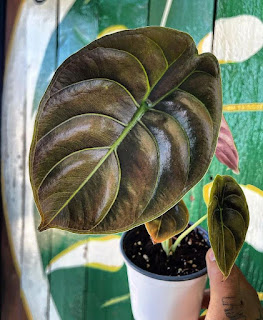Introduction to Alocasia:
Alocasia plants, commonly known as Elephant's Ears, are a stunning genus of rhizomatous or tuberous tropical foliage plants belonging to the Araceae family. Native to Southeast Asia and the Pacific Islands, they are loved for their large, often textured leaves and unique patterns. There are about 90 accepted Alocasia varieties many of which are in constant rotation around the shop!
Caring for Alocasia in Denver:
Proper Watering: Alocasia prefer consistently moist soil, that is never waterlogged. Water thoroughly when the top inch of soil feels dry, during the growing season. Usually in the fall and winter I prefer to let them GENTLY dry out throughout the entire pot. When in doubt, a good rule is to allow the plant to dry out at least 50% of the way. Like I always say, more often than not, too dry is preferable to too wet.
Use room temperature water and thoroughly water the soil directly, avoiding the leaves to prevent fungal issues. Using cold water can shock the plant and lead to heavy leaf loss.
 Ensure proper drainage to prevent root rot, especially in colder/darker months when overwatering can be more damaging. Using a high quality premixed soil or a specialty mixed soil is the best way to give yourself a bit of an insurance policy against rot.
Ensure proper drainage to prevent root rot, especially in colder/darker months when overwatering can be more damaging. Using a high quality premixed soil or a specialty mixed soil is the best way to give yourself a bit of an insurance policy against rot.Lighting: Alocasias thrive in bright, indirect light. Avoid placing them in direct sunlight as it can scorch their leaves. East or west-facing windows with filtered sunlight are ideal. If you have a south-facing window, place the plant further away from the window to avoid direct sun exposure.
Fertilization: In simple terms during the active growing season (spring and summer) I like to fertilize heavily. For liquid, synthetic/organic fertilizers I recommend fertilizing at 1/2 strength on every watering with a distilled water leeching every 3-4 months. Fall and winter as the plant enters its semi-vegetative stage I like to keep the same frequency but reduced to 1/4 strength. You are able to fertilize frequently throughout the entire year because of our geographic location. Slow release fertilizers like Nutricote should be applied on their appropriate schedule regardless of season.
Humidity: Alocasias prefer/require higher humidity levels to thrive. In Denver's dry climate, consider using a humidifier or place the plant on a humidity tray filled with water and pebbles. I usually do not recommend misting as a way of adding humidity to the plant, but if you wish to do so I recommend that you use distilled/purified water to avoid fungal and or bacterial issues associated with tap water.
Common Pests: Alocasia plants can be susceptible to common houseplant pests such as spider mites, aphids, and mealybugs.
 Regularly inspect the plant for signs of infestation, such as webs, tiny moving insects, or yellowing leaves. Isolate any affected plant immediately to prevent the pests from spreading. Treat pests with an insecticidal product following the instructions on the product label.
Regularly inspect the plant for signs of infestation, such as webs, tiny moving insects, or yellowing leaves. Isolate any affected plant immediately to prevent the pests from spreading. Treat pests with an insecticidal product following the instructions on the product label.Best Soil Type: A well-draining and nutrient-rich potting mix is essential for Alocasia plants. Opt for a mix that is peat moss free, perlite, and orchid bark to ensure proper aeration and drainage. Don't forget we carry a selection of high quality, hand mixed soils at the shop.
Summary:
Lighting: Provide bright, indirect light, and avoid direct sunlight.
Fertilization: For liquid fertilizers: 1/2 strength every watering spring and summer. 1/4 strength every watering in the fall and winter. Leech the soil every 3-4 months to wash out mineral build up in the soil
Humidity: Maintain higher humidity levels using a humidifier or pebble tray
Pests: Watch for common pests and treat promptly if detected.
Soil: Use well-draining and nutrient-rich potting mix.
With proper care, your Alocasia plant will flourish and become a beautiful centerpiece in your Denver home, adding a touch of tropical elegance to your indoor space. Remember to observe your plant regularly and adjust its care as needed to ensure it remains healthy and vibrant.
As always, if you have any questions or comments, feel free to contact me via email: helloplantroom@gmail.com or on social media @theplantroomdenver! Thanks for reading!



Comments
Post a Comment